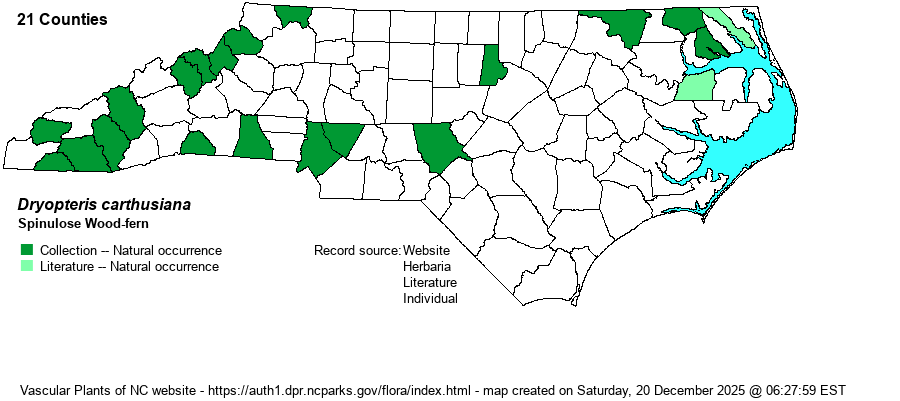| Author | (Villars) Fuchs | |
| Distribution | Widely scattered in the Mountains and Piedmont, and in the northern Coastal Plain; specimens from 20 counties. Most of these collections have been made in recent decades, as there were collections from just two counties listed in RAB (1968). The reasons for this uptick are not known.
This is a widespread Northern species, ranging across Canada, south to VA, OH, and IA, but quite scattered south to SC and AR.
| |
| Abundance | Rare to locally uncommon in the Mountains, very rare in the southern Piedmont (and oddly no records yet for most of the northern and central Piedmont); rare to uncommon in the northern Coastal Plain. Though there are collections from 1/5th of the state's counties, they are mostly scattered, and indeed this is a rare enough species to justify being on the NCNHP's Watch List. | |
| Habitat | This is mainly a wetland species, growing in acidic soils, most often in swampy woods, but also in bogs, seepages, and other damp places. However, it does not seem to be present in pocosins or near other acidic pinelands, but is found mostly in poorly drained wet hardwood or mixed forests and springs/seeps. | |
| Phenology | Fruits from June to September. | |
| Identification | This is a lacy-cut fern of swampy woods, poorly known to most state biologists, usually identified by process of elimination rather than outright straight identification, owing to its rarity or unfamiliarity. It has a deciduous to semi-evergreen blade that is about twice as long as the stipe, and the blade is triangular in shape, about 15 inches long and 8 inches wide. It is bipinnate-pinnatifid, with each pinnule having lobes nearly cut to the midrib. The blade is thus a bit similar to the lacy blade of D. intermedia, but that species has an evergreen blade (not obvious in spring or summer), the blade is more parallel-sided rather than more triangular, and has a difference in the basal pinna shape. D. intermedia has the first bottom or down-pointing pinnule of the lowest pinna shorter than the second pinnule (next to it), whereas D. carthusiana and D. campyloptera have this pinnule clearly longer. In D. carthusiana this same first pinnule is about twice as long as the opposite pinnule (the one pointed toward the apex), whereas in D. campyloptera this first bottom pinnule is 2.5-5 times as long as the opposite one pointing to the apex. These two species should not overlap in elevation, as D. carthusiana should be found in lower montane elevations in seepages, bogs, or swampy places, whereas D. campyloptera grows only on mountaintop forests. All Dryopteris species have rounded sori on the blade undersides, in rows along pinnule midribs. | |
| Taxonomic Comments | Many older references named this as D. spinulosa, including RAB (1968). Others named it as D. austriaca var. spinulosa.
| |
| Other Common Name(s) | Toothed Wood-fern | |
| State Rank | S2 | |
| Global Rank | G5 | |
| State Status | W7 [W1] | |
| US Status | | |
| USACE-agcp | FACW link |
| USACE-emp | FAC link |

